This wacky wildlife post is a co-creation by my son JY and me – our first collaborative piece. 😀 It focuses on the avifauna (a.k.a birds) of Australia. The photos and videos were taken by JY, my partner Young Whan and me. We saw these birds in June and July 2024, during our first Big Bird Year, in which JY recorded over 300 species of birds!
Jump to:
- Bird love backstory
- Trip overview
- 1. Brisbane: Australian Ibis, Southern Boobook
- 2. Noosa: Pied Butcherbird (video), Rainbow Lorikeet, Laughing Kookaburra, Tawny Frogmouth
- 3. Lady Elliot Island, Great Barrier Reef: Buff-banded Rail (video), Black Noddy, Red-tailed Tropicbird
- 4. K’gari (Fraser Island): Bush Thick-knee
Bird love backstory
Sophy: “Birds are my balm.” This is what Russ, our birding guide in Noosa, said when I asked him what got him into birding. As a retired hospice social worker, I imagine he’s witnessed a fair amount of suffering. I can see (and feel!) how spending time in nature and watching birds is healing.
While JY has loved birds (especially penguins) since he was two years old, his interest exploded during the pandemic. He opened our eyes to the avian world. The quietude of being stuck at home made us much more aware of our feathered friends in our backyard and urban neighborhood. Now we are much more attuned to this whole other amazing world in the sky. Birding has gotten us outside more often, given us newfound amazement for nature, connected us to something far greater than ourselves, and changed our lives for the better. Birds have also become our balm. We are happy to share this love of birds with you.
Trip overview
Below are the locations where we took the photos and videos featured in this post. We chose our trip locations for their accessibility (for walking, taking public transit, and rental car driving) and ability to see wildlife.
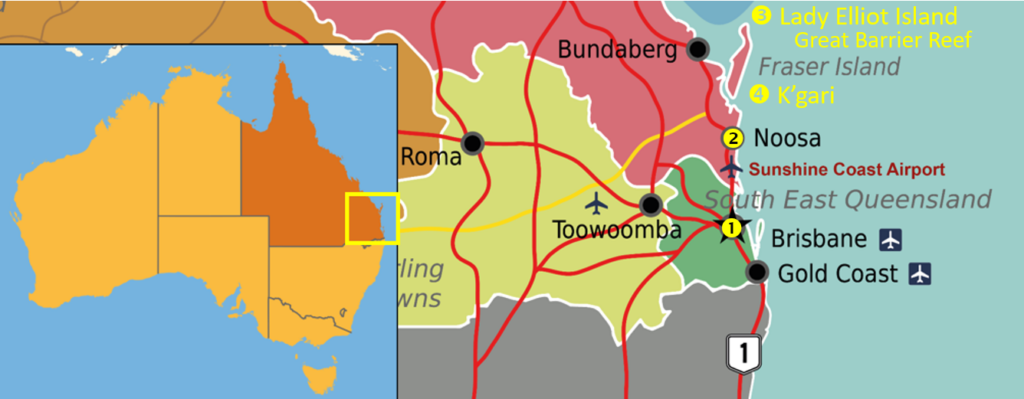
1. Brisbane
Australian Ibis
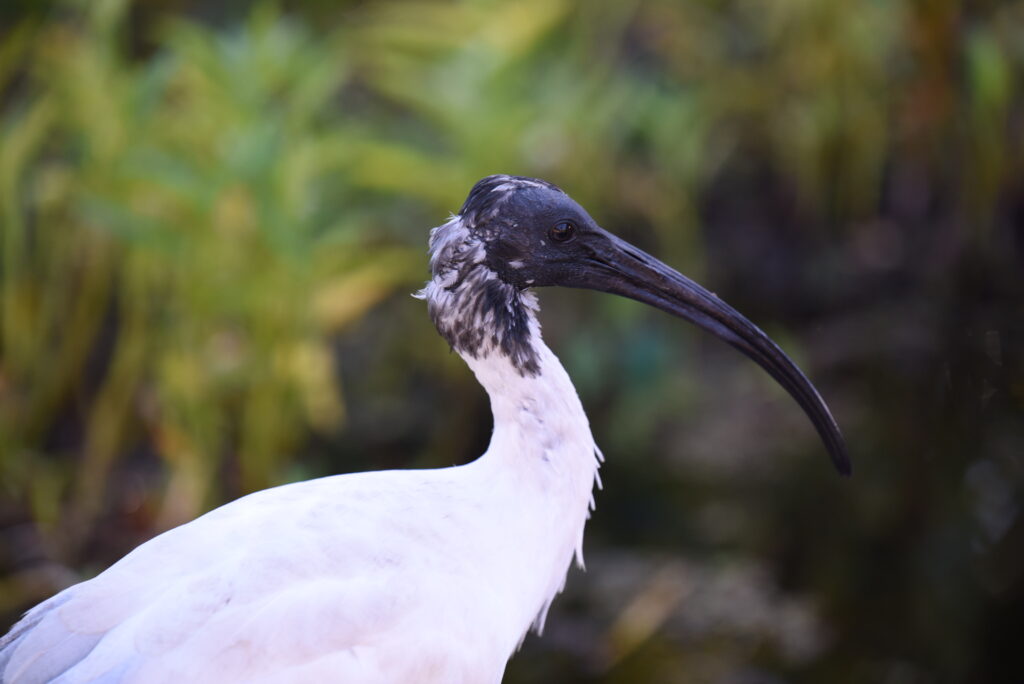
JY: After a long plane ride (14 hours!) and a morning chilling in our apartment, me and my dad decided to take a walk in a nearby park (the South Bank Parklands). We were astounded to find many Australian Ibises. Being from the United States, to us these birds seem exotic and unusual, with their snowy white plumage and odd-looking bill. But in Australia, they’re so common that they’re nickname is “bin chicken” because they will find food in trash bins and landfills.
Southern Boobook
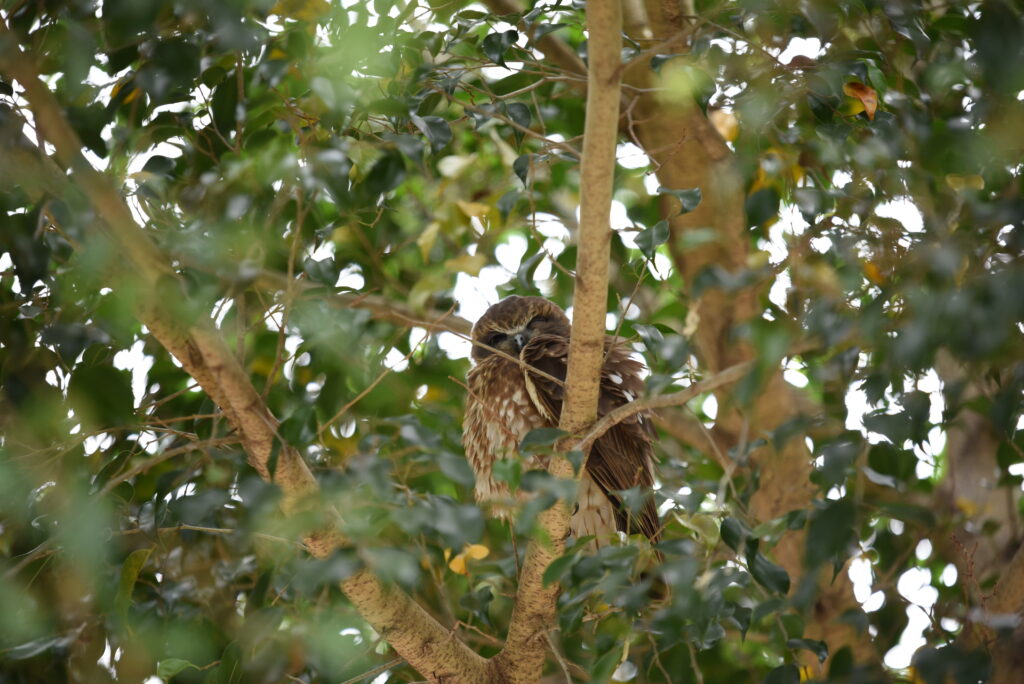
JY: As me and my dad were about to leave the South Bank Parklands, we spotted this tree where some crows and Noisy Miners (a type of bird) were making a ruckus. When we investigated, I saw a white and rufous rump. At a different angle, that rump turned out to be an owl’s! As we took pictures, the owl woke up (because of us and the racket of other birds) and gave us the stink eye. I was delighted! We looked in our field guides and had a dispute about whether the owl was a Powerful Owl or a Barking Owl (it was neither). A week later we looked more carefully in our field guides and found out that the owl was actually a Southern Boobook, a common urban owl. The Southern Boobook is also Australia’s smallest owl at 28-35 cm (11-14 in) in length.
2. Noosa
Pied Butcherbird
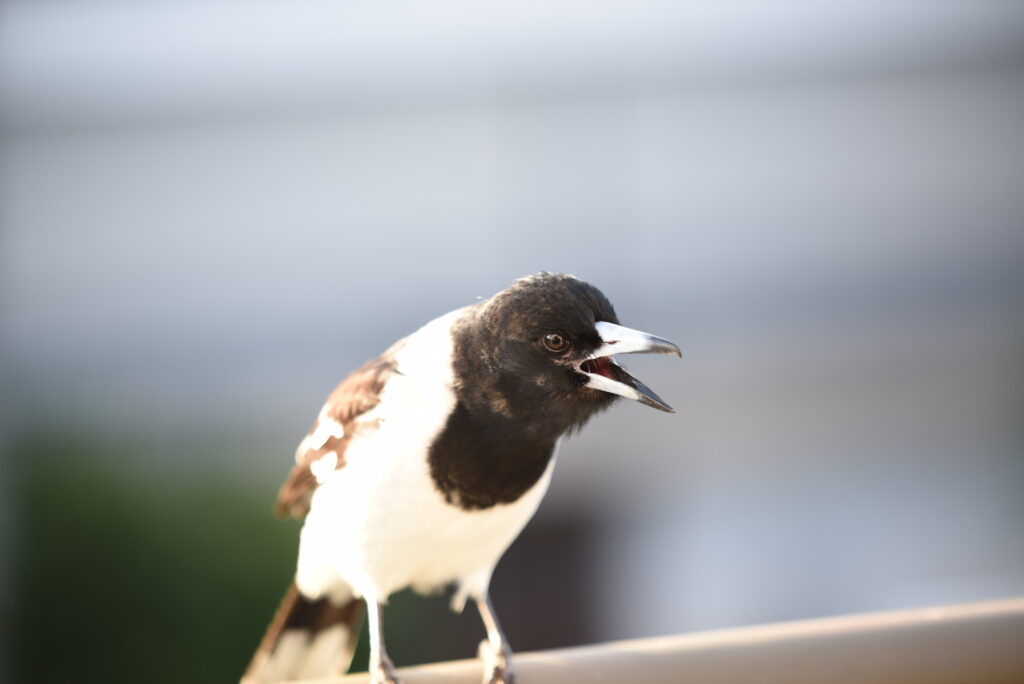
This brave and talented Pied Butcherbird brought their family over to our deck and serenaded us with a beautiful medley. Check out a video of them singing to us below!
Sophy: Pied Butcherbirds enchanted me on the first day I set foot in Oceania. Soon after I arrived, I heard their haunting song from my apartment in the heart of the bustling metropolis of Brisbane, Australia. “Where is this magic flute coming from?” I wondered and half-expected to see the Pied Piper wandering the alleyways below. Eventually, not seeing anyone with a flute, I whipped out the Merlin Sound ID app. No, it wasn’t the Pied Piper. It was a Pied Butcherbird!
Pied butcherbird songs quickly became my soundtrack for coastal Queensland and greeted us each morning around dawn. What a lovely way to start the day. Their elegant voice belies the fact that they are also aggressive hunters, perching on branches and posts and pouncing on insects, skinks, frogs, rodents and small birds. They will sometimes store their food to eat later by impaling their prey on sticks or wires, or by placing them in holes and crevices – behavior that earned them the “butcher”part of their name.
First Nations people respect and honor butcherbirds for their tight communities, fierce care for their young, and powerful songs passed on from generation to generation. As Birpai Elder and Knowledge Keeper Aunty Rhonda Radley says in the video below, “if you listen to their song, it has the potential to lift you up, to make you happy and joyful.”
On our last day on Sunshine Beach in Noosa Shire, I went out to our apartment balcony to watch the sunrise and listen to the cacophony of sounds from Torresian crows, currawongs, lorikeets, friarbirds, magpies, and of course, butcherbirds. As if they knew I was a superfan and was leaving that day, a family of Pied Butcherbirds landed on the balcony ledge, just a few feet from where I was sitting. Then they serenaded us, first as a trio, then in solos, and finally in a duet from an adult-juvenile pair. These day songs are thought to promote bonding and act as communication between birds. “And maybe me!” I thought as they stayed and sang for us for over 15 minutes. I certainly felt bonded to them. They have forever enchanted me with their beautiful songs.
Rainbow Lorikeet
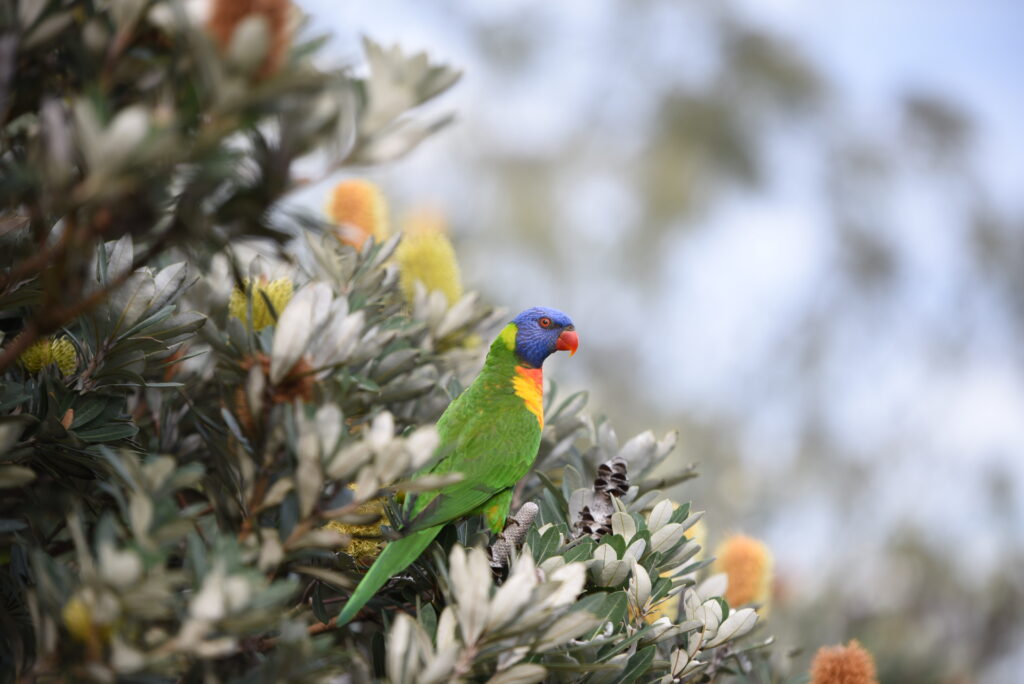
Sophy: On my first afternoon in Brisbane, I saw in the Queensland Art Gallery courtyard in a delirious, jet-lagged haze. Loud, colorful darts cut through the sky, gathering in raucous groups in the tree canopies. I was mesmerized. I watched them noisily chew apart the flowers from a eucalyptus tree. My curiosity was piqued. I wanted to learn more. Merlin Sound ID could not discern their identity from the cacophony, and my backlit phone photos showed blurry shadows whizzing across the bright sky, so Merlin Photo ID and Google Lens did not help either. Who are these dazzling beings??
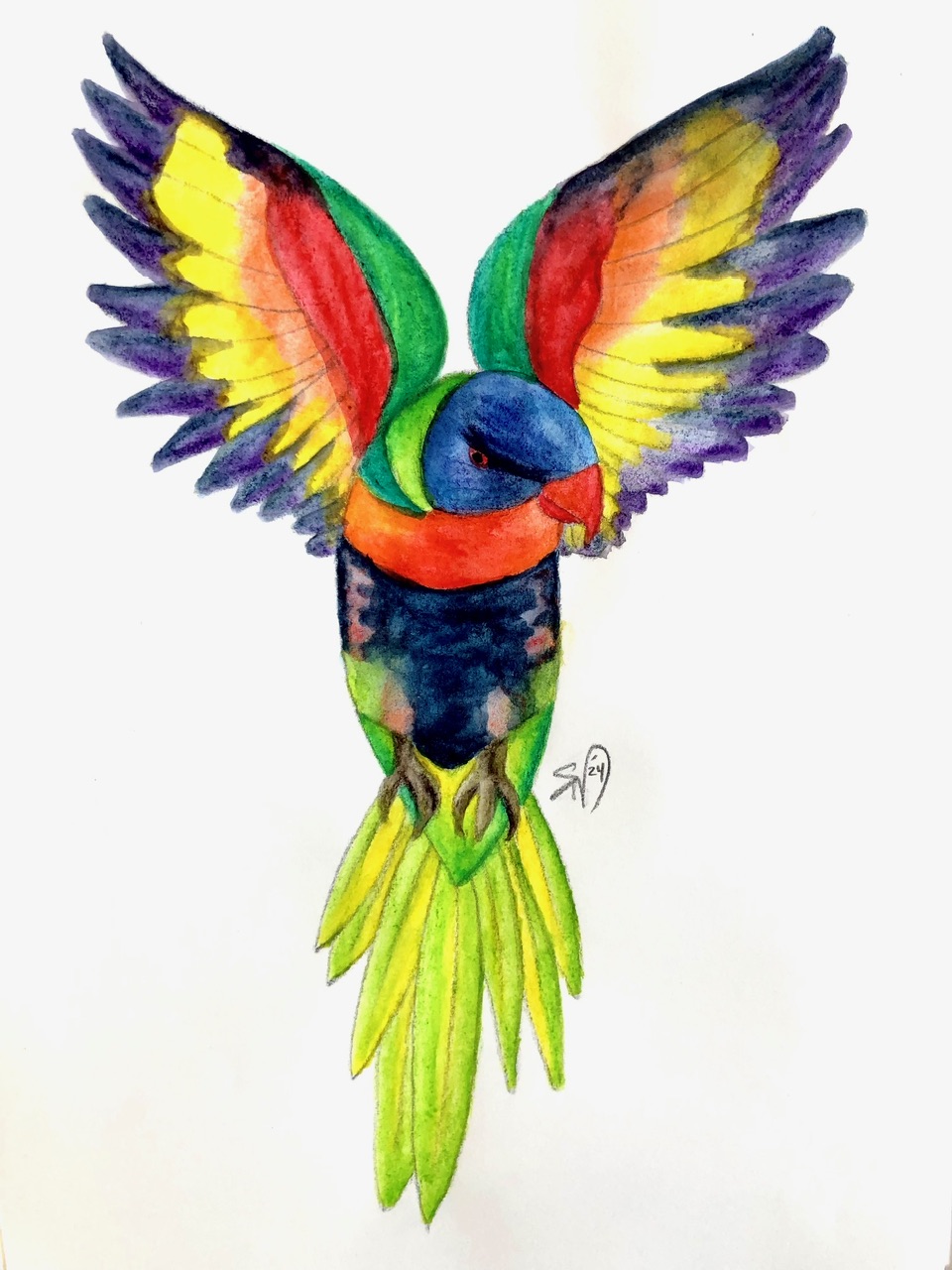
An old-school bird guide book revealed that they were Rainbow Lorikeets. (I highly recommend Darryl Jones’ excellent and cheeky Getting to Know the Birds in Your Neighbourhood as a great beginner’s guide to birds in Australia. The cover endorsement declares it “An absolute ripper.”) Every morning in Noosa, the Rainbow Lorikeets brought color to my mornings, landing in the banksia trees outside my windows and chewing at the funky brushy flower spikes. My phone camera was too slow to catch a good photo or video of them and their frenzied movements, so I illustrated one instead. It wasn’t until my partner Young Whan arrived with his SLR camera and spotted one perched unusually still on a Banksia tree along the Noosa National Park coastal walk that we finally captured the beauty of their colors in the photo above.
Rainbow Lorikeets are both loved and hated in Australia. In Western Australia, they became invasive pests when they escaped from cages brought over from Northern Australia in the 1960s. Since then they have devastated fruit orchards and driven out native species with their competitive eating and breeding habits. For First Nations people in Northern Australia, a Dreamtime story tells us about the Rainbow Bird, who stole fire from the selfish crocodile and flew across the land to give everyone light and heat. As she flew, the fire sparked colorful lights across her body, and she became the Rainbow Bird.
Laughing Kookaburra
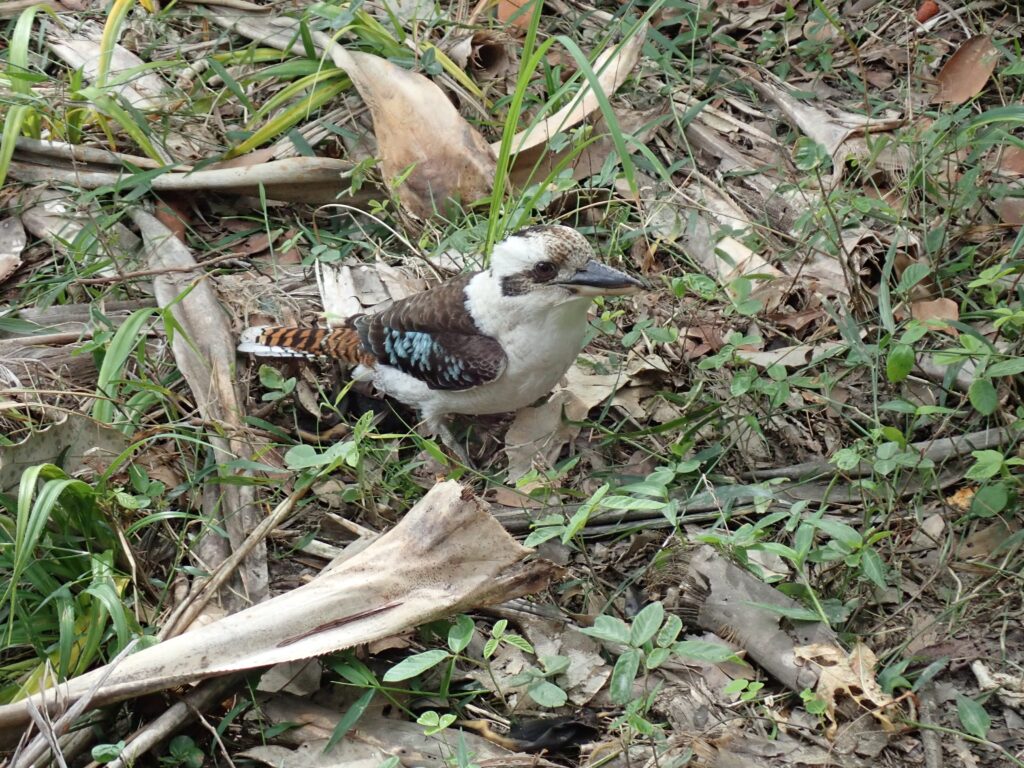
Sophy: I was hiking back from Alexandria Bay one afternoon by myself at dusk. The gray sky was drizzling rain, and the darkened, damp trail was eerily empty of humans. Suddenly, I heard crazy laughing sounds coming from all around me. One side of the forest would rise up in a chorus of cackles, then another side would loudly laugh in response. It was a surreal experience, being in the dark rainy forest by myself, surrounded by what I initially thought were bands of monkeys up to no good.
What monkeys are here?? I asked myself, and then my phone. No cell reception, no answer. Only laughs. My anxious part felt like they were laughing at me (which of course they were not), and I hurried along the trail, slipping and sliding on the wet fallen eucalyptus leaves, hoping that these “monkeys” were not interested in interacting with me. As I exited the trail, I recorded their sound, hoping to figure out what they were.
When I later played the recording for a local Noosa resident, she told me they were birds, not monkeys! Silly me. Even sillier was how Laughing Kookaburras endeared themselves to me during our time in Queensland, completely transforming from the scary Joker Monkeys in my imagination to the beautiful and curious kingfishers that they actually are.
The young Laughing Kookaburra above was photographed by JY after landing next to him along the Noosa National Park coastal walk. This young bird was exploring and checking JY out for a while, hopping around and looking at him for several minutes. The elders appeared to be in a tree across the trail, watching us, perhaps making sure their young one remained safe. Kookaburras live in family groups and are cooperative breeders, with young kookaburras helping parents hunt and care for new generations of offspring.
In the video below, Birpai Elder and Knowledge Keeper Aunty Rhonda Radley tells the story of her grandson’s totem, or animal kin, which is Gaaku (the Kookaburra). After she tells her 4-year-old grandson about his Gaaku totem, a baby Kookaburra comes down and sits with him. Her story reminds me of this wonderful moment JY had in Noosa with the young Kookaburra.
Ricky Ah-See, Wiradjuri Elder, tells us the First Nations story of Why the Kookaburra Laughs in the video below. In this Dreamtime story, the Laughing Kookaburras agreed with the Sky People to wake up the Sun every morning with their call. I love how these totems and stories connect humans so closely with our natural world in creative and respectful ways.
Tawny Frogmouth
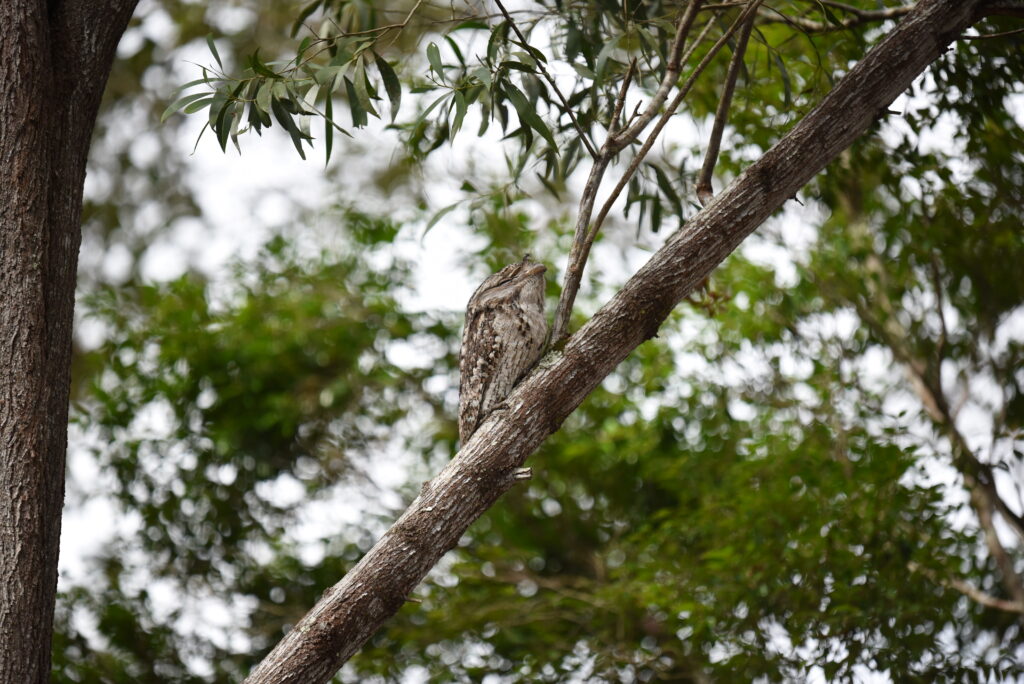
JY: As soon as my dad found out about this bird, the Tawny Frogmouth, we set out to see one in the flesh. We were connected to the Noosa Parks Association Bird Observers Group, who happened to host a group bird walk in a spot where Tawny Frogmouths were seen regularly. We drove over and met the group and asked about the Tawnys. They said the last sighting was at a bus stop. Our group of about 20 people headed over, but we were bummed after a little searching when we couldn’t find it. We were about to leave, disappointed. Suddenly, one of our group members, Bob, called out from the nearby parking lot. We all hustled over, excited. There it was, in full glory, right next to where we parked our car, a Tawny Frogmouth pretending to be a branch. A Tawny Frogmouth is related to nightjars and Potoos, and is nocturnal and eats bugs and fish. During the day they remain inconspicuous by imitating a branch, a behavior known as “stumping.” We had walked right under it earlier, and didn’t spot it because it was so camouflaged!
3. Lady Elliot Island, Great Barrier Reef
Buff-banded Rail
JY: As the plane touched down onto the grassy runway of Lady Elliot Island, I spied little brown dots. When we got off the plane, our welcoming guide told us they were Buff-banded Rails. Buff-banded Rails are usually difficult to see on mainland Australia, but here they were approachable and pretty feisty and territorial (as shown in the video). And they were everywhere on the island, especially near the dining halls, looking for tasty morsels.
Black Noddy
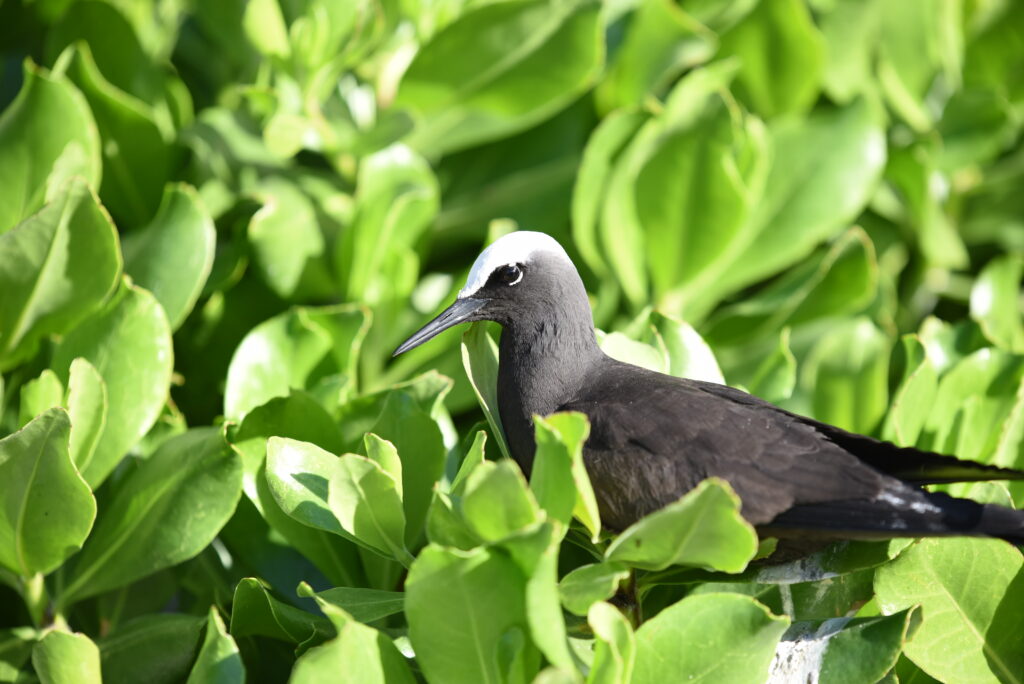
JY: When we arrived at the cabin to unpack and unwind, we were greeted by this guy, a Black Noddy. A Black Noddy is an oceanic tern, spending the day out on the ocean. But the Black Noddy in the photo was one of the only noddies that didn’t go out during the day. I didn’t know what kept them, but I was glad for his company. I had a lot of fun watching and interacting with that Black Noddy. But the Noddy party wasn’t over yet! (I’m saying Noddy too much)
Later, watching the sunset, we spotted a line of dots on the horizon. It was a huge group of Noddy returning from the sea after a long day. As they passed over, there seemed to be hundreds, maybe thousands of them! But after that, we spotted another similarly large group coming in. The chattering of hundreds of roosting Noddies was so noisy, but in the morning the only trace of them was the guano on the trees.
Red-tailed Tropicbird
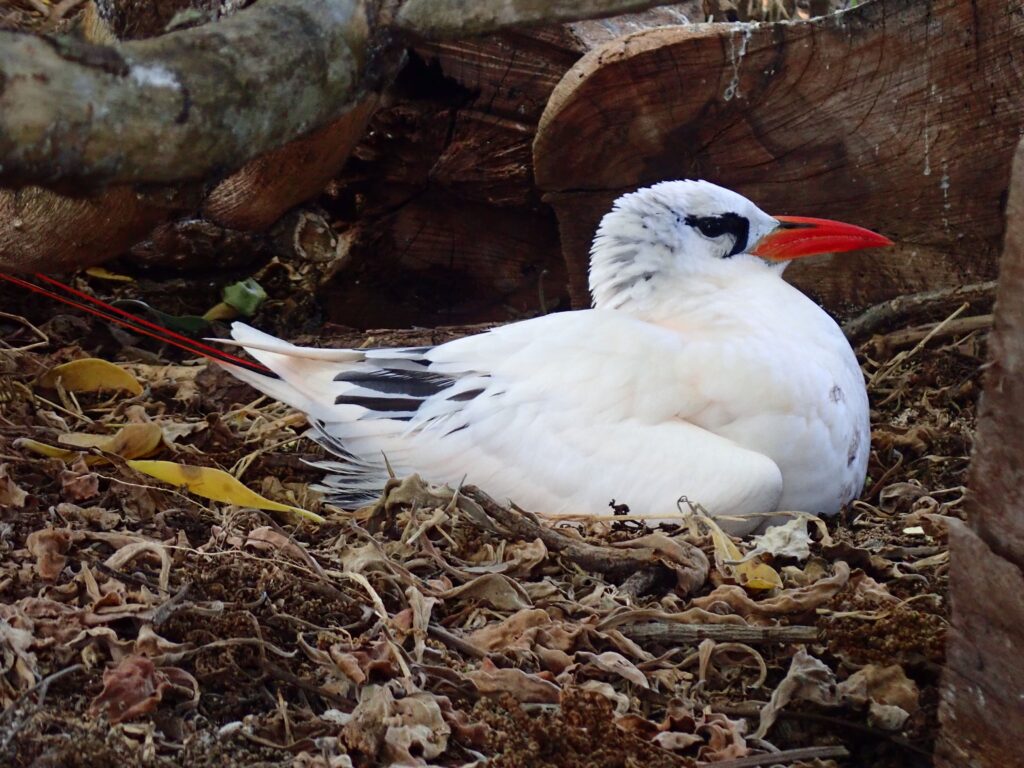
Sophy: While walking along the coral beach of Lady Elliot Island, JY and I spotted a pair of beautiful, elegant birds with bright red bills and long red tail streamers dancing around each other in the air. We were witnessing the aerial courtship dance of Red-tailed Tropicbirds, seabirds that breed on remote oceanic islands. The Leaf to Reef biodiversity research project discovered that Lady Elliot Island has hosted the oldest known nesting Red-tailed Tropicbird at 23 years of age.
We were fortunate to visit the island during the Red-tailed Tropicbird’s nesting season. We saw the birds at various ages: eggs, a chick (named Libby by the Leaf to Reef team), a young courting pair, and older parents sitting on their eggs. The males and females take turns incubating eggs and feeding in the open ocean for 2-3 days at a time. They are skillful plunge divers that eat mostly squid and fish.
Amazingly, the Red-tailed Tropicbirds on Lady Elliot Island nested under octopus bushes right outside our cabins. They didn’t seem too disturbed by us, except for one skittish mama whom we tried to give space to. JY would make daily rounds to see how each nest was doing.
One afternoon, we saw a parent flying in a swap position with their mate on the nest, elegantly navigating the air and then landing in comically clumsy skids and thuds into the octopus bush. Turns out they don’t move around well on land with their stubby and webbed ocean-paddling feet.
We also saw Libby the chick get fed by her parents once. The rest of the time she would cry and cry. One of the researchers told us that she was about 2 months old, and it was time for her to go out to sea to feed herself. Apparently Red-tailed Tropicbirds learn to fly and feed by instinct once they stop getting fed. Her parents were trying to get her to go out on her own by no longer feeding her. Talk about crying it out!
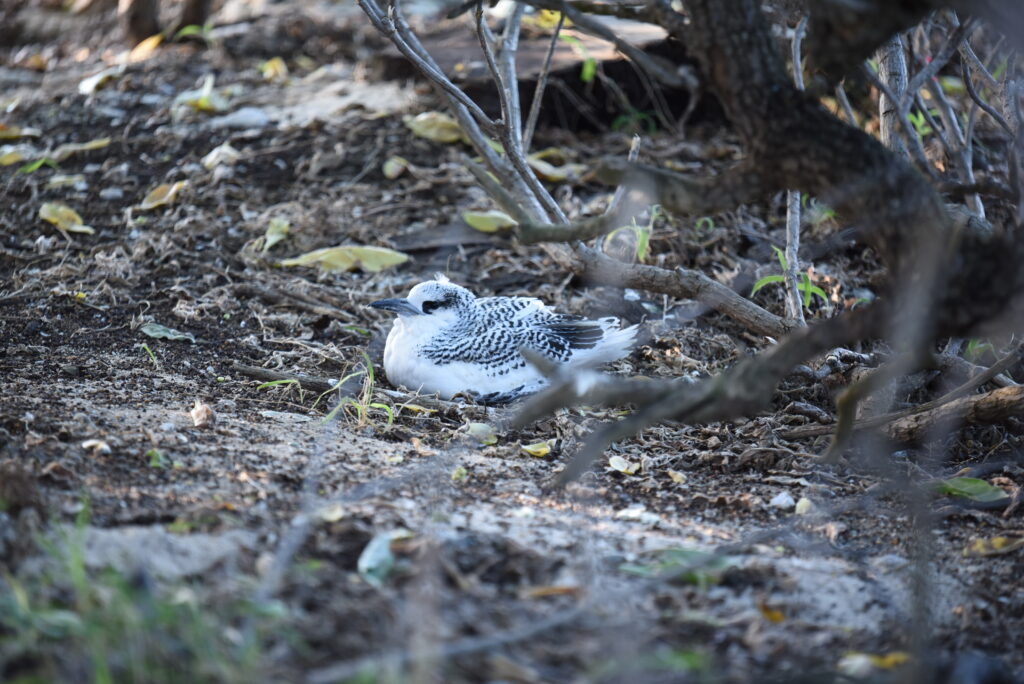
4. K’gari (Fraser Island)
Bush Thick-knee

JY: We were all taking a tour on K’gari, the world’s largest sand island. After the lunch stop there was still time before continuing on, so we decided to explore. As we approached a bakery, someone spotted this bizarre looking bird. Was it a statue? No, it moved! And it was a Bush Thick-knee. I was in love with this bird! It looked so wacky! When I was taking some photos of it, it gave me this intense stare. What a weird bird.
These are the Top-Ten birds of our Australia trip! Thank you for reading and sharing in our curiosity and wonder of these beautiful and weird birds. 🙂

Love hearing about all these birds. So many good memories from this trip!
Amazing stories and amazing images!